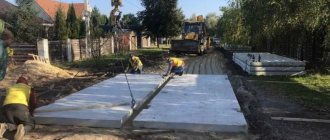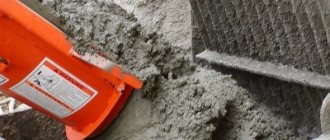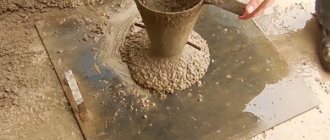Preface
- 1 DEVELOPED by the Limited Liability Company "Center for Metrology Testing and Standardization" (LLC "TsMIiS") together with the Autonomous Non-Profit Organization "Scientific* Research Institute of Transport and Construction Complex" (ANO "NII TOK")
- 2 INTRODUCED by the Technical Committee for Standardization TK418 “Road Facilities”
- 3 APPROVED AND PUSHED INTO EFFECT by Order of the Federal Agency for Technical Regulation and Metrology dated May 31, 2022 No. 267-st
- 4 INTRODUCED FOR THE FIRST TIME
The rules for applying this standard are established in Article 26 of the Federal Law of June 29, 2015 No. 162-FZ “On Standardization in the Russian Federation”. Information about changes to this standard is published in the annual (as of January 1 of the current year) information index “National Standards”, and the official text of changes and amendments is published in the monthly information index “National Standards”. In case of revision (replacement) or cancellation of this standard, the corresponding notice will be published in the next issue of the monthly information index “National Standards”. Relevant information, notifications and texts are also posted in the public information system - on the official website of the Federal Agency for Technical Regulation and Metrology on the Internet (www.gost.ru)
© Statsdartinform. decor. 2019
This standard cannot be fully or partially reproduced, replicated and distributed as an official publication without permission from the Federal Agency for Technical Regulation and Metrology
Purpose of core sampling
In contrast to non-destructive testing methods carried out directly at the site of road work (for example, using radiometric probing), the selection of cores and their subsequent analysis in the laboratory allows us to obtain a significantly larger volume of data both on the quality of work (quality of primer before paving, quality of laying and asphalt compaction), and according to the characteristics of the asphalt concrete material itself. Thus, the main purpose of core sampling is to assess and control the quality of road works and materials during the construction of asphalt concrete pavements. Depending on the type of road work, the following tasks are solved using core sampling:
- quality control of the laid asphalt concrete mixture;
- control of the degree of adhesion between layers;
- determination of the thickness of asphalt concrete coating layers;
- determination of asphalt concrete density;
- determination of water saturation of asphalt concrete;
- determination of compressive strength;
- analysis of the grain composition of the asphalt concrete mixture.
The need to select cores for laboratory research most often arises in the following cases:
- At the initial stage of road construction, when selecting the optimal composition of the asphalt concrete mixture for paving various layers of the road base and road surface.
- To assess the degree of destruction of existing road pavement and the prospects for its safe operation.
- In case of disagreement between the customer and the contractor. Laboratory examination of cores makes it possible to determine deviations from standards during construction, identify violations of technology, and detect discrepancies between the materials stated in the estimate and those actually used in asphalt paving. The results of laboratory analysis of cores can be used in judicial practice.
Laboratory core testing
Before starting laboratory tests, the lower part of the core must be sawed off. This is necessary in order to remove residual bitumen on the bottom surface of the sample, applied by pouring bitumen (“primer”). The sawing thickness should be 5–10 mm depending on the thickness and texture of the bottom of the cutting.
Also, before testing, cores are dried to constant weight at a temperature of no more than 50 °C. Each subsequent weighing is carried out after drying for at least 1 hour and cooling at room temperature for at least 30 minutes. The mass of the sample is determined by weighing it on a balance.
As a result of laboratory core studies, the following is determined:
- thickness of the compacted layer of the road surface and/or road base;
- average density of asphalt concrete;
- splitting strength;
- degree of adhesion between layers.
After basic testing, the cores can be remolded. Reshaping the core is heating it in a sand bath or in a heating cabinet, then crushing it with a spoon or spatula and re-creating a cylindrical sample. By examining remolded cores, the following indicators are determined:
- grain composition of the mineral part of the mixture (by burning out the binder);
- compressive strength at temperatures of 20 °C and 50 °C;
- tensile strength (required to predict the resistance of an asphalt pavement to fatigue and temperature cracks);
- water resistance;
- water saturation;
- mixture compaction coefficient (defined as the ratio of the average density of the core to the average density of the remolded sample).
It should be borne in mind that the confidence probability of assessing the properties of asphalt concrete determined from samples reformed from core samples is significantly lower than from samples made from mixtures, and therefore the test results of reformed samples cannot provide an objective assessment that could serve as a rejection criterion. In this regard, the number of cores taken from the asphalt pavement and the number of repeated tests for each specific case should be considered separately, and statistical methods should be used to justify the defect.
Regarding the assessment of the grain composition of the mineral part of asphalt concrete mixtures based on the results of core testing, the results cannot be considered sufficiently reliable for a number of reasons. Firstly, during transportation of the mixture, as well as during its laying, segregation of crushed stone is observed, and hence a certain heterogeneity of its distribution in the laid layer. To obtain reliable data that makes it possible to assess with a high degree of probability the composition of the laid asphalt concrete mixture, it is necessary to select samples from the pavement in the quantity necessary for statistical assessment.
Secondly, when the coating is compacted, crushed stone can be crushed. And thirdly, when taking samples with a core sampler, crushed stone is crushed in the zone of sawn edges. Depending on a number of reasons, such as the type of mixture, the size of the cores, etc., the crushed stone content in the cores can be up to 20% lower than the crushed stone content in the asphalt concrete mixture itself, which was used for paving.
Laboratory instruments for asphalt concrete
Modern road construction is one of the most material-intensive sectors of the national economy, requiring significant investment. Under these conditions, quality control of materials both during their production and use has become an obligatory component in road construction. It is necessary to take into account that currently not only the range of materials used is rapidly expanding, but also the list of indicators that require monitoring is increasing. To ensure the fulfillment of these requirements, not only new technologies are needed, but also means of both laboratory and operational field control of the materials and components used, as well as the physical, mechanical and geometric parameters of the resulting coatings.
Currently, the Group produces a large range of modern instruments and control equipment that can be used not only by road laboratories and construction organizations, but also used as part of mobile road laboratories. The range includes instruments and equipment for diagnostics and control during road construction, laboratory instruments for testing asphalt concrete and its components, cement concrete, soils, as well as quality control of rough surface treatment and paint and varnish materials used in road construction.
In addition to traditional equipment using well-known mechanical and geometric measurement methods, such as a road rack, a device for monitoring the geometric parameters of highways, a rutting meter, a dynamic density meter, a long-base deflection meter, a balloon density meter, a penetrometer and many others, the company is successfully mastering the production of automated equipment, including themselves electronic, electromechanical and software components. Some of them are combined into sets of equipment that allow solving problems of a whole area in the study of new properties of road materials. Currently, in the Russian Federation, the design of asphalt concrete based on physical indicators (according to GOST 12801) is being replaced by methods of volumetric design based on operational characteristics: according to Marshall and Superpave (GOST 58401, GOST 58406). The Marshall method is based on designing the composition of an asphalt concrete mixture compacted using an impact compactor and tested for 4 indicators: density, residual porosity, stability and conditional plasticity.
Since 2022, our company has been producing a set of instruments for testing according to the Marshall method: a Marshall compactor (impact compactor), a vacuum pycnometer, a crimping device for testing samples according to the Marshall method (GOST R 58406.8-2019), a device for determining the tensile strength in indirect tension ( GOST R 58401.18-2019), support device for testing samples for bending (GOST R 58406.6-2020). The impact compactor is designed for preparing cylindrical samples with a diameter of (101.6±0.1) mm and a height of (63.5±2.5) mm, as well as samples with a diameter of (152.4±0.2) mm and a height of (95. 2±2.5) mm from asphalt concrete road mixture and asphalt concrete, intended for the construction of structural layers of pavement on highways in accordance with GOST R 58406.9-2019. The sample is formed into a special shape under the impacts of a falling weight. The machine automatically compacts the sample at 50 blows per minute and stops after a preset number of blows are completed.
The operating principle of a vacuum pycnometer is based on determining the density of a crushed sample of asphalt concrete mixture after removing air voids. Removal of air voids is achieved by vacuuming a sample of the asphalt concrete mixture in conjunction with the use of light vibration. The installation is designed to obtain a certain amount of vacuum in the working chamber, necessary to determine the following indicators: - maximum density of the asphalt concrete mixture; — content of air voids in asphalt concrete; — voids filled with bitumen binder; — true density of the asphalt concrete mixture according to GOST 12801-98; — water saturation according to GOST 12801-98.
Another example of an integrated approach to solving several problems simultaneously within one set is the small-sized hydraulic press PGI-500, produced by the company since 2003. The press, which develops forces up to 500 kN (50 tons), was originally intended for compression testing of asphalt concrete samples and other building materials at a deformation rate of no more than 4 mm/min. Consistent improvement of the design, hydraulic circuit and software of the press made it possible to increase the speed initially to 10 mm/min, and subsequently to 150 mm/min. This made it possible to form asphalt concrete samples in accordance with the requirements of GOST 12801-98 “Materials based on organic binders for road and airfield construction. Test methods". As a result of recent modernization, the technological and operational capabilities of the press have been significantly expanded. The range of operations performed on the press is supplemented by a whole range of tests provided for by GOST 12801-98, and carried out at a speed of movement of the lifting plate of 50 mm/min: determination of shear resistance characteristics during compression with a special crimping device according to the Marshall scheme; determination of shear resistance characteristics under uniaxial compression; - determination of tensile strength during splitting. The press allows not only testing samples, but also preparing asphalt concrete samples by pressing. To achieve the rate of load increase required by GOST 12801, the press provides an appropriate high speed of movement of the lifting plate - up to 150 mm/min. This requirement is often not met by other similar small-sized testing machines. The stroke of the lifting plate has been increased from the previous 45 to 70 mm, which expands the capabilities of the press when testing crushed stone for crushability using any, including low-strength, grades of materials. To measure the magnitude of displacements and deformations of samples, a non-contact laser sensor is used in the new design, which increases the reliability of the press and the accuracy of the test results obtained. The press can be equipped with a device for extracting asphalt concrete samples from molds in accordance with GOST 12801. The device operates from the press pumping station and is easily integrated into its hydraulic system. The press control panel can be connected to a personal computer, which allows processing and storing test results, presenting them in any convenient form (in the form of tables, graphs, etc.), calculating a number of parameters and maintaining a database of test results with the possibility of their subsequent documentation. At the customer's request, the press can be equipped with appropriate accessories. Thus, at present, the PGI-500-02 press is a certified measuring instrument of an approved type, which can be considered a universal testing set of equipment that provides the entire technological cycle of laboratory work on testing samples of asphalt concrete materials, starting from their preparation, removal from molds and the entire complex tests in automatic modes under compression to the full extent of the requirements of GOST 12801-98. A similar press, but with a force of up to 1000 kN (100 tons), is intended mainly for testing cement concrete and other building materials.
In modern conditions, the transport load on the road surface is determined mainly by trucks having an axle pressure of 10 - 13 tons, and in some cases even higher. Despite the measures taken, in recent years there has been an increase in the length of road sections with ruts. Until recently, in Russia, the assessment of the ability of asphalt concrete to resist the development of plastic deformations in it was assessed according to GOST 12801. However, such test modes, as well as the equipment used, do not correspond to the actual operation of asphalt concrete in the pavement, during which it is subjected to repeated exposure to wheel loads that are significantly less than compared to destructive. Wheel load testing methods have proven themselves positively in many countries around the world, and in EU countries they are included in the asphalt concrete design procedure. In this case, equipment is used that, until recently, had no domestic analogues. The development of new methods for assessing the shear resistance of asphalt concrete in our country was hampered by the lack of domestic equipment that allows us to simulate in the laboratory the processes occurring in real conditions, starting with the preparation of the mixture, the method of its compaction, as well as the mechanical impact of wheel load on the road surface.
To prepare and form asphalt concrete samples in laboratory conditions in accordance with GOST 58406.4-2020, the company has developed a sector press PS-30 with a maximum developing force of 30 kN (3 tons). The press simulates in the laboratory real conditions for compacting an asphalt concrete mixture with a road roller. The sample is compacted using a smooth roller sector (roller) in metal molds 305x305 mm. The resulting samples are then used to test the quality characteristics of the asphalt concrete mixture using the Superpave system: - slab samples - for resistance to rutting in accordance with GOST R 58406.3-2020 on UK-2 installations; — beam samples (prisms) cut from slabs — for fatigue strength during repeated bending using the 4-point method according to GOST R 58401.11-2019; — drilled cores — for static and dynamic creep, tension during splitting, etc. The operating mode is fully automatic. The compaction parameters are set from the built-in control unit. Selection of compaction modes: - according to a given program (load value and number of roller passes); - up to the specified height of the sample.
The UK-2 installation is intended for testing asphalt concrete samples for rutting in accordance with GOST R 58406.3-2020. The installation simulates the process of deformation of road surfaces under the influence of repeated wheel loads of vehicles. Tests are carried out automatically with indication and storage of both intermediate parameters (number of exposure cycles, rut depth, test temperature) and their final results. The installation has a climate chamber with a system for automatically setting and maintaining the required temperature during the entire test period. Based on the results of tests carried out at the installation, it is possible to determine the shear resistance indicators of asphalt concrete samples, which allows, already at the design stage, to select optimal mixture compositions in order to increase their service life in real conditions.
The main advantages of the installation: — testing in an automated mode; — digital indication of all required process parameters; — ability to connect to a personal computer; — full compliance with the requirements of the domestic regulatory framework. The installation may be of interest to design organizations studying road pavement compositions, with the possibility of calculating normalization of loads and temperatures, and the permissible plasticity rut depth on newly constructed and existing highways.
Sample testing
Test methods for asphalt concrete according to GOST
The properties of AB are the object of laboratory research. Moreover, both the ingredients of the mixture, the AB after mixing, and samples of the finished coating are tested.
The purpose of the study is to assess the compliance of the parameters of the prepared AB with GOST standards.
Sample preparation
At the first stage, samples are prepared.
- Laboratory - dried stone and sand are heated and dosed according to the recipe. Dehydrated bitumen is heated, all ingredients are mixed manually and then in a laboratory mixer. Temperature and time are observed.
- Samples from the mixers are taken immediately after unloading the product - 3-4 portions from each batch. Samples are pooled and mixed to obtain an average sample.
Since some tests require compaction of the sample, it is performed on a press:
- with a crushed stone share of up to 35% - by pressing at 40 MPa;
- with a crushed stone share of more than 35% - vibration at 0.03 MPa. and additional compaction at 20 MPa;
- cold samples are compacted in a press at 40 MPa.
Cores are used to control the behavior of the finished product. They are obtained by cutting down using a pneumatic hammer or by drilling through the entire thickness of the coating.
Let's talk further about testing asphalt concrete in the laboratory.
This video will tell you about sampling for testing asphalt concrete:
Laboratory tests
First of all, the average density of AB is established:
- the prepared samples are weighed in air;
- Places in water for half an hour;
- weighed in water;
- wiped and weighed again in the air.
The results are calculated as the arithmetic mean of the density of at least 3 samples.
True Density
Determination of true density, that is, without taking into account pores, by the pycnometric method:
- the average sample of the mixture or core is crushed to the maximum grain size in the AB composition;
- weigh a portion of the mixture and place it in a flask. Fill 1/3 with distilled water with surfactant;
- the flask is placed in a vacuum cabinet under a pressure of no more than 2000 Pa;
- the flask is filled with water to the mark, the pressure is reduced to 1 atm and the sample is again left for half an hour;
- weighed in water.
The result is the arithmetic mean based on at least 2 samples.
Water saturation
Determination of water saturation, that is, an assessment of the volume of water that the AB absorbs under given conditions. The test examines the same samples on which the average density was measured:
- samples are placed in a container and filled with water - no less than 3 cm;
- the container is placed in a vacuum device under a pressure of 2000 Pa. The holding time for hot and warm mixtures is 1.5 hours, for cold ones – 30 minutes;
- the pressure is lowered to normal. The holding time for hot and warm mixtures is 1 hour, for cold ones – 0.5 hours;
- samples are removed from the container, wiped and weighed.
Tensile strength
Assessing the tensile strength comes down to determining the load at which the battery will begin to collapse. The studies use samples that have been tested for water saturation:
- samples of the hot and warm mixture are kept in a water bath for 1 hour, samples of the cold mixture are kept in an air environment for 2 hours. Ice water is used for cooling;
- The sample is placed in the middle of the asphalt concrete testing press plate, the top plate is lowered until the distance to the sample reaches 1.5–2 mm. Then turn on the electric motor;
- the maximum value of the force meter is taken as the destructive load.
Water resistance coefficient
Water resistance coefficient - the ratio of the strength of dry AB to the strength of the material subjected to prolonged water saturation - 15 days:
- the sample is weighed in air and water;
- saturate with water in a vacuum device according to the method described above;
- water-saturated samples are transferred to a container and kept for 15 days at a water temperature of 20 C;
- samples are removed, wiped and subjected to tensile strength testing.
Content
- 1 area of use…………………………………………………………………………………………………._
- 2 Normative references
- 3 Terms and definitions
- 4 Requirements for measuring instruments, auxiliary devices and materials
- 5 Test method
- 6 Safety and environmental requirements
- 7 Requirements for test conditions
- 8 Preparation for testing
- 9 Test procedure
- 10 Processing of test results
- 11 Registration of test results
- 12 Monitoring the accuracy of test results










